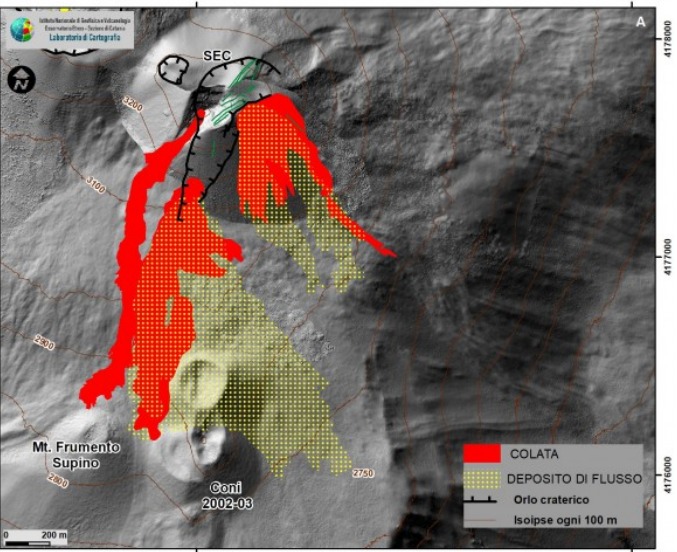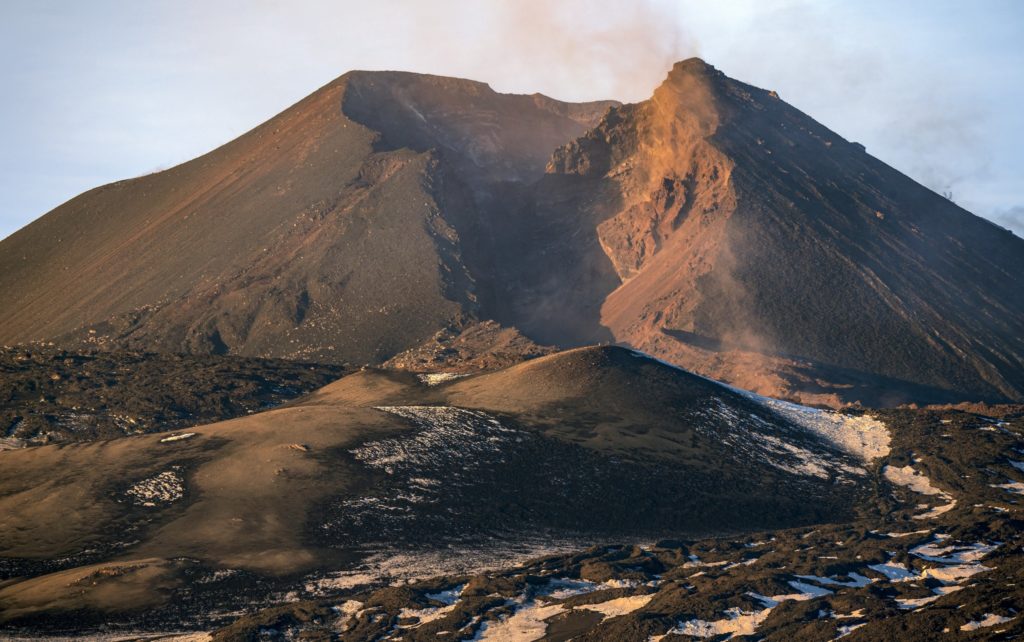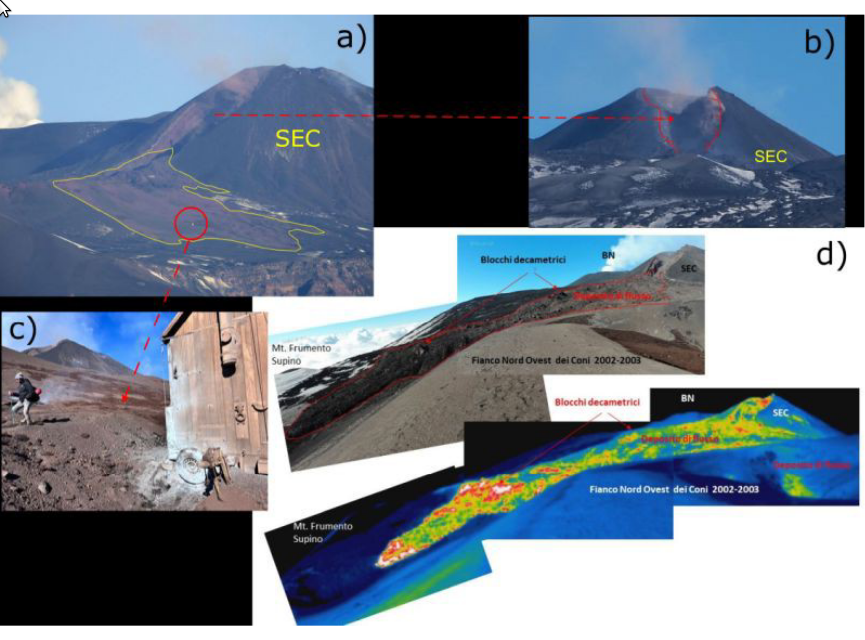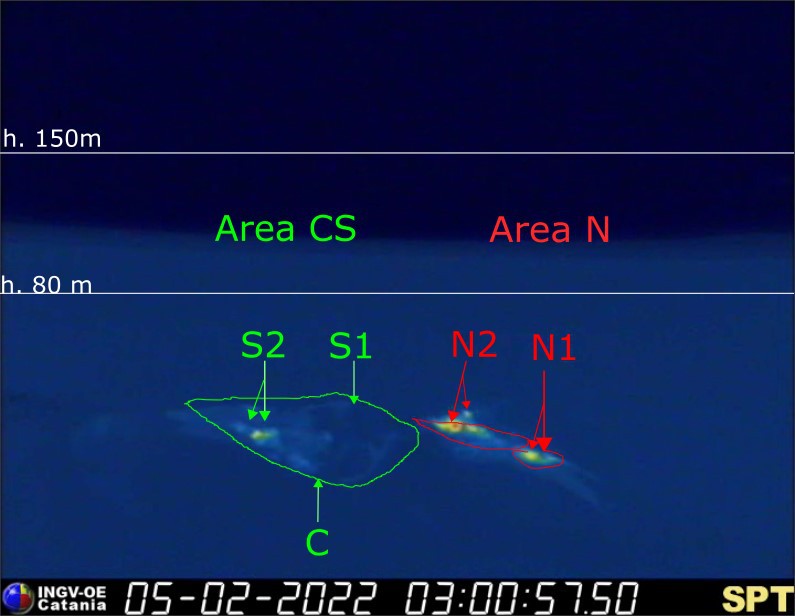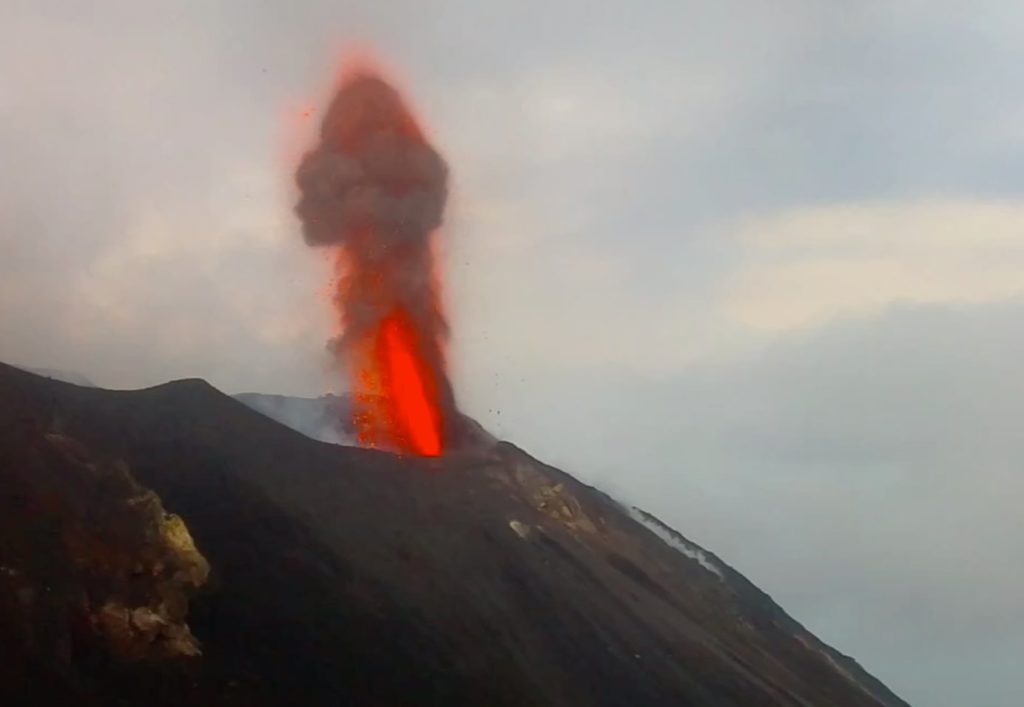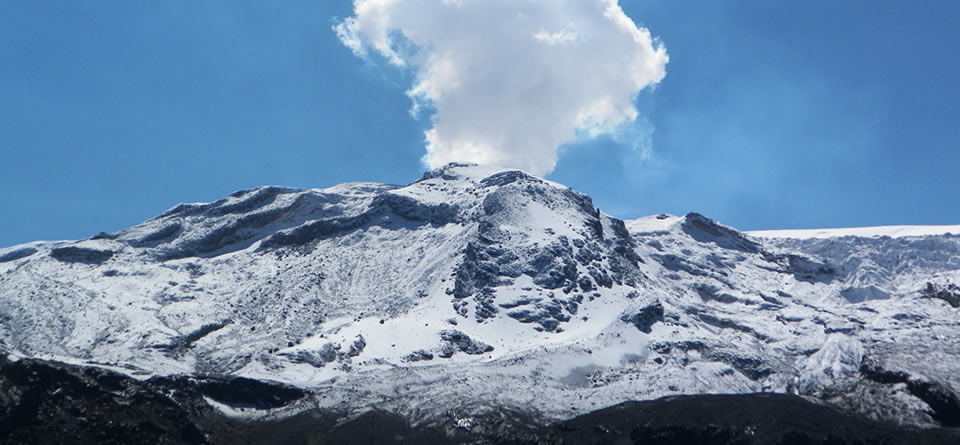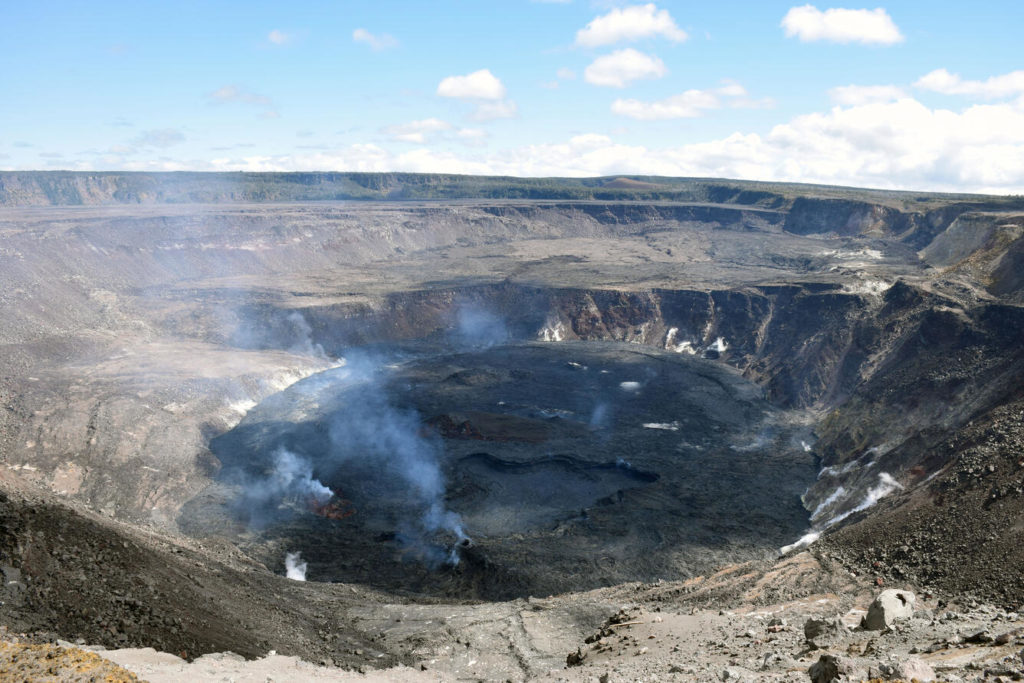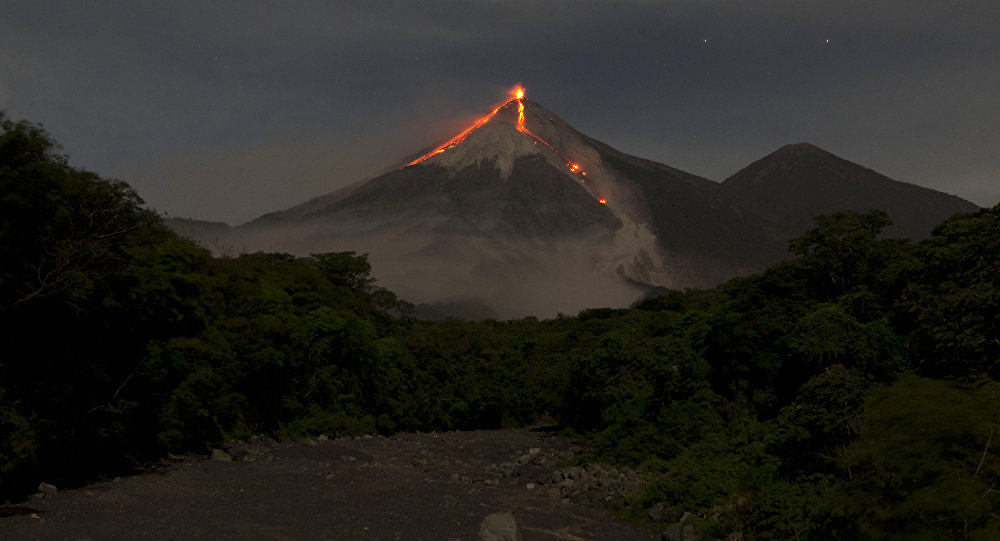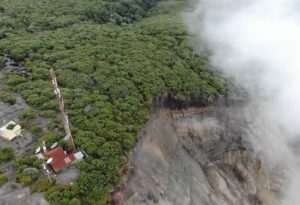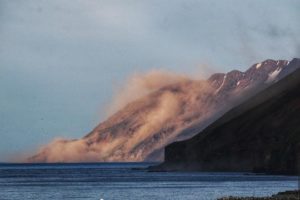February 16 , 2022.
Italy / Sicily , Etna :
WEEKLY BULLETIN from February 07, 2022 to February 13, 2022 (Issue date February 15, 2022)
ACTIVITY STATUS SUMMARY.
In the light of the surveillance data, it is highlighted:
1) VOLCANOLOGICAL OBSERVATIONS: Strombolian activity and lava fountain of the Southeast Crater; continuous degassing and sporadic ash emissions from the Bocca Nuova crater; fumarolic degassing of the Voragine crater; ordinary degassing with sounds of explosions and discontinuous and modest emissions of ash from the northeast crater.
2) SEISMOLOGY: very low seismic fracturing activity; average amplitude of the volcanic tremor generally on low and medium levels with the exception of the February 10 lava fountain where very high values were reached.
Geological map on a shaded terrain model. In red the flows and rheomorphic flows, in dotted lines
yellow the pyroclastic deposit.
3) INFRASOUNDS: Medium-high to very high infrasound activity.
4) GROUND DEFORMATIONS: Ground deformation monitoring networks have observed variations in the time series from the February 10 lava fountaining episode. In particular, the tilt network showed changes of modest amplitude. The ECP (Cratere del Piano) station was the most characterized by the aforementioned variations in the time series.
5) GEOCHEMISTRY: SO2 flux at a low level
Soil CO2 flux shows average values.
The partial pressure of dissolved CO2 in the aquifer shows values in seasonal variability.
The latest available data shows medium-high values (data of 01/26/2022) equal to XXXX, settling on medium-high values.
6) SATELLITE OBSERVATIONS: Thermal activity in the summit area was high to very high in correspondence with the February 10, 2022 lava fountain.
VOLCANOLOGICAL OBSERVATIONS
During the week, the monitoring of the volcanic activity of Etna was carried out through the analysis of images from the network of surveillance cameras of the INGV section of Catania, Etneo Observatory (INGV-OE) and through two field inspections of part of the INGV personnel on February 12 and 13, 2022. During the observation period, the activity mainly concerned the Southeast Crater (SEC) and only marginally the others summit craters which showed variable degassing activity at Northeast Crater (NEC), Bocca Nuova (BN) and Voragine Crater (VOR).
On the night of February 9 to 10, the resumption of modest explosive activity was observed at the level of the Southeast Crater, highlighted by incandescences visible on the cameras. The activity was – at that time – confined inside the crater and generated discontinuous and light ash emissions.
At 03:27 UTC on February 10 (15 hours before the paroxysm) the ETNAS early warning system signals the passage to the first alert level (A1), corresponding to the high probability of imminent appearance of lava fountains.
From 14:20 UTC on February 10, a modest lava flow from the Southeast Crater, which flows in a West – Southwest direction, is observed.
From around 4 p.m. UTC, there was, in alternating phases in terms of intensity and frequency, a decisive intensification of Strombolian activity, while the lava flow still seems to be fed and the front has reached an altitude estimated at about 2900 m above sea level.
From approximately 20:40 UTC, the passage of Strombolian activity towards lava fountains is observed, which reach heights of approximately 1000-1500 m above the top of the cone, while the eruptive cloud produced by the activity in course, up to about 12 km above sea level, is scattered in the western sector of the volcano and the lava flow has continued to be well fed.
Around 20:35 UTC, the first pyroclastic flows formed on the southern flank of the Southeast Crater. In particular, at 8:40 p.m. and 9:19 p.m., two flows of pyroclastic material traveled a few hundred meters in the direction of Valle del Bove.
At 21:26 UTC, the largest pyroclastic flow occurred, which extended south and southeast, completely covering the northernmost crater from the 2002-2003 eruption (Mt Barbagallo), covering 1 .6 km and stopping at an altitude of 2750 m above sea level, after damaging a hangar which was on its way. The flow generated a deposit consisting of materials with variable grain sizes ranging from decametric blocks to fine sands.
Lava fountain activity ceased around 22:00 UTC. For a few hours, the eruptive cloud produced by the activity remains in the atmosphere and disperses in the western sector of the volcano. The lava flow seems to be still fed and the front is at an altitude of about 2850 m while modest explosive activity is still observed in the lower part of the open fracture in the southern flank of the Southeast Crater cone.
After the end of the paroxysmal activity, a weak and discontinuous intra-crater explosive activity persists, which produces a weak emission of ash, dispersed in the atmosphere in the northwest sector of the volcano. The lava flow of the Southeast Crater seems to be no longer fed and is cooling. The front reached an altitude of 2830 m above sea level, west of Monte Frumento Supino and traveled 1.5 km. On the south side of the Southeast Crater, it is possible to observe the deep niche left by the paroxysmal activity and inside which small collapses of unstable material occur, with consequent emissions of contained ash.
On the basis of the direct observations made during the inspection of February 13, a preliminary calculation of the volume of the deposit was carried out: the deposit was divided into zones of homogeneous thickness, each of them being assigned an average thickness .
The edge of the collapse was traced in the PlanetScope satellite image from February 14, which shows that the escarpment is about 500 m long and varies in width from a maximum of 190 to a minimum of 100 m. Inside the escarpment you can see at least 2 septa that remained anchored to the cone and a series of the green-lined fractures in Figure 1C. The indented blue line shows what the crater rim looked like on February 8. The red circles indicate the flow emission points.
Fig.3.4 Overview of the pyroclastic flow deposit at 21:26 UTC on February 11 (a) with detail of the large niche on the southern flank of the Southeast crater and the damage to the hut along its course ( vs). in (d) panoramic view of the visible and thermal of the same deposit, taken during the inspection of February 13, from which emerges the high temperature of the same despite the time that has elapsed since its emission.
The eruptive column produced by the paroxysmal activity dispersed in the northwestern sector of the volcano, causing fallout of pyroclastic material on the settlements of the northwestern quadrant of the volcanic edifice (notably in Maletto) and up to the Tyrrhenian coast of Sicily, S. Agata di Militello and Capo d’Orlando.
Finally, at approximately 10:25 UTC on February 11, a small effusive vent opened at the southeast base of the Southeast Crater cone, about 3000 m a.s.l., from which a modest amount of ash is emitted as well as ‘a short and stubby lava flow that only flows a few tens of meters towards the South-East towards the Vallée de Bove, to then stop and cool completely in the following days. With regard to the remaining craters, Bocca Nuova (BN) was characterized by impressive continuous degassing and sporadic emissions of dilute ash. The Northeast Crater (NEC) produced ordinary degassing. Finally, the Voragine crater was characterized by fumarolic degassing.
Source : INGV.
Photos : INGV , Giuseppe Distefano , Giuseppe Distefano / Marco Restivo , INGV.
Italy , Stromboli :
WEEKLY BULLETIN from February 07, 2022 to February 13, 2022 (Issue date February 15, 2022)
ACTIVITY STATUS SUMMARY
In the light of the surveillance data, it is highlighted:
1) VOLCANOLOGICAL OBSERVATIONS: During this period, normal explosive activity of the Strombolian type was observed with projection activity in the N zone. The total hourly frequency of explosions fluctuated between average values (12 events/h) and high values (21 events/h). The intensity of the explosions was low in the area of the North crater and variable from low to medium in the area of the Center-South crater.
2) SEISMOLOGY: The seismological parameters monitored do not show any significant variations.
3) GROUND DEFORMATIONS: The Stromboli ground deformation monitoring networks did not show any significant variations
4) GEOCHEMISTRY: SO flux at an average level
CO2 flux in the crater area stable at high values.
The C/S value in the updated and validated plume in the plume is 11.84, settling at medium-high values.
The isotopic ratio of helium, slightly decreasing, is at average values of R/Ra 4.36
5) SATELLITE OBSERVATIONS: The thermal activity observed by satellite was at a low level.
VOLCANOLOGICAL OBSERVATIONS
During the observation period, the eruptive activity of Stromboli was characterized through the analysis of images recorded by the INGV-OE surveillance cameras (altitude 190m, Punta Corvi, altitude 400m and Pizzo). The explosive activity was mainly produced by 3 (three) eruptive vents located in the North crater area and 3 (three) eruptive vents located in the Center-South crater area. All the mouths are located inside the depression which occupies the terrace of the crater.
Due to the unfavorable weather conditions of February 7, 2022, the visibility of the crater terrace was insufficient for a correct description of the eruptive activity.
Sector N1 located in the North crater area produced mainly low intensity explosions (less than 80 m high) emitting fine materials (ash) mixed with coarse materials (lapilli and bombs). Sector N2, with two emission points, showed low intensity explosive activity (less than 80 m in height) emitting coarse materials with intense discontinuous projection activity for short periods in the period from 09 to 12 February . The average frequency of explosions varied from 3 to 13 events/h.
In the Center-South zone, sector C did not show any significant explosive activity. Sector S1 showed jets of incandescent gas which from February 11 mixed with coarse materials while the two vents placed in sector S2 produced explosions, even simultaneously, of mainly medium-low intensity (sometimes the products of the explosions exceeded 80 m in height) emitting coarse materials mixed with fine materials. The frequency of the explosions varied between 4 and 9 events/h.
Source : INGV.
Photos : INGV , web cam skynet
Colombia , Nevado del ruiz :
Subject: Nevado del Ruiz volcano activity level bulletin.
The activity level continues at the yellow activity level or (III): changes in the behavior of volcanic activity.
Regarding the monitoring of the activity of the Nevado del Ruiz volcano, the COLOMBIAN GEOLOGICAL SERVICE reports that:
The seismicity related to fluid dynamics inside the volcanic conduits showed a decrease in the number of earthquakes and an increase in the seismic energy released, compared to the previous week. This seismic activity was characterized by the occurrence of continuous volcanic tremors, harmonic tremors, pulses of tremors, some with spasmodic characteristics, long-period type earthquakes and very long periods. In general, these signals exhibited moderate to low energy levels, variable spectral content, and were located primarily within Arenas Crater. Thanks to the cameras installed in the volcano area, the gas and ash emissions associated with some of these signals have been confirmed. Likewise, thanks to the FLIR cameras of the volcanic monitoring network, it was possible to observe significant changes in the relative temperature of the materials emitted, such as those recorded on the morning of February 11 during a small explosion. The recording of new seismic signals of this type that may be associated with gas and ash emissions with or without changes in relative temperature, which will be dispersed depending on the prevailing wind regime at the time of emission, is not excluded, and / or small emissions of volcanic materials that may be deposited inside the crater and on the surrounding areas.
The seismicity generated by the fracturing of the rocks showed a decrease in the number of earthquakes and a decrease in the seismic energy released, compared to the previous week. This seismic activity was located mainly in the Arenas crater and in the southeast sector of the volcano. The depth of the earthquakes varied between 0.5 and 7.0 km. The maximum magnitude recorded during the week was 1.5 ML (Local Magnitude), corresponding to the earthquake recorded on February 10 at 07:29 (local time), located in the Arenas crater, at a depth of 1.4 km.
During the week, there were two episodes of low energy « drumbeat » type seismicity, which were recorded on February 10. This seismicity has been linked to the processes of ascent, emplacement-growth and evolution of a lava dome at the bottom of the Arenas crater.
Source : SGC
Photo : Milton_H_Arias
Hawaii , Kilauea :
19°25’16 » N 155°17’13 » W,
Summit Elevation 4091 ft (1247 m)
Current Volcano Alert Level: WATCH
Current Aviation Color Code: ORANGE
Activity Summary:
The summit eruption of Kīlauea Volcano, within Halemaʻumaʻu crater, has continued with minor fluctuations in lava output over the past 24 hours. All recent lava activity has been confined to the crater, and there are no indications of activity migrating elsewhere on Kīlauea.
Halemaʻumaʻu Lava Lake Observations:
Effusion of lava from the western vent within Halemaʻumaʻu crater has continued over the past 24 hours. On February 14, 2022, at 3:50am HST, the lava lake surface began to rise, in conjunction with inflation of the summit, and by 12pm that day, its elevation was 835m (2740 feet) above sea level. The lava lake surface level then remained relatively constant until 2:40am HST this morning when the summit entered a period of deflation. As of 8:30am HST this morning, the lava lake surface has fallen 5m (16 feet). The active lava lake is now approximately 89 meters (292 feet) deep relative to when lava emerged on September 29, 2021. Measurements on January 25, 2022, indicated that the total lava volume effused since the beginning of the eruption was approximately 45 million cubic meters (12.0 billion gallons) at that time.
Summit Observations:
Summit tiltmeters indicated that Kīlauea summit was entering a period of inflation beginning yesterday at 3:45am HST. Inflation continued until 11pm yesterday, at which point summit tiltmeters indicated static or unchanged deformation at the summit. Beginning at 2:40am HST this morning, the summit entered a period of deflation that is ongoing. Seismic data shows that the volcanic tremor signal has persisted through the entire 24-hour period. However, at 7:50am HST this morning, the strength the volcanic tremor signal decreased. Earthquake activity at the summit remains below background level. A sulfur dioxide (SO2) emission rate of approximately ~2800 tonnes per day (t/d) was measured yesterday, February 14.
Source : HVO
Photo : USGS / L. DeSmither
Guatemala , Fuego :
SPECIAL VOLCANOLOGICAL BULLETIN; INCREASE IN VOLCANIC ACTIVITY.
Since February 9 of this year, the activity of the Fuego volcano begins an effusive phase which generated a lava flow in the direction of the Ceniza ravine, with a length which varied between 75 and 200 meters. Seismic and acoustic monitoring parameters and field observations made by OVFGO observers indicate that starting yesterday (February 14), said effusive activity has increased, generating periods of high activity that last from a few minutes to a few hours. .
As a result, the extrusion of magmatic material generates greater degassing and incandescence at night and early in the morning. Strombolian-like explosions increased in number and intensity, and sounds similar to train locomotives and airplane turbines were more prolonged. The RSAM graph (Figure 1) reflects the increase in amplitude of seismic station FG16 and its tendency to continue to show periods of increase above its baseline activity.
FIGURE 1. RSAM graph showing some recent episodes of increased activity.
Due to the above, it is expected that the lava flow will continue to be active and even increase its length in the following hours or days, causing constant avalanches towards the Ceniza ravine as well as prolonged degassing and incandescence in the crater. In the next few hours or days, moderate to strong explosions of the Strombolian type should continue, accompanied by rumblings, shock waves, noises of degassing and avalanches through the various ravines. It is not excluded that other lava flows are generated in the other ravines or that an explosive activity of greater intensity and with an emission of abundant materials (gas / ashes).
Source : Insivumeh.
Photo : Moises Castillo / Sputnik. (archive).


